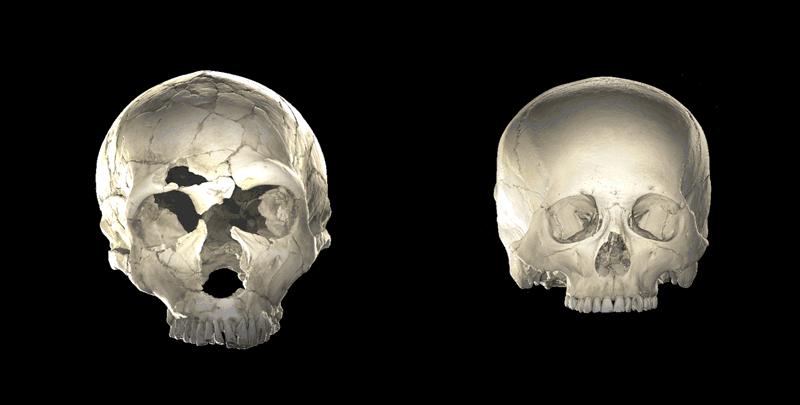Hello Nature readers, this is the news that matters in science today. You can also sign up to get it free in your inbox.

Neanderthal skulls (left) are more elongated than modern-human skulls.Credit: Philipp Gunz
Neanderthal DNA shaped some human brains
Interbreeding tens of thousands of years ago might have produced “a really subtle shift in the overall roundedness” of the brains of some people with European ancestry. Neanderthal DNA variants seem to affect the expression of two genes in such a way as to make the brains of some humans slightly less round, and more like the Neanderthals’ elongated ones. There is no evidence that the genes affect cognition or any trait other than brain shape.
Massive ocean carbon sink spotted burping CO2
The Southern Ocean’s complex contribution to the global carbon cycle is coming to light, thanks to a fleet of robotic floats that are gathering detailed data for the first time. The waters around Antarctica slow global warming by absorbing heat and carbon dioxide from the atmosphere. But, during the winter months, the deep waters that rise to the surface release massive quantities of centuries-old carbon. The latest findings reveal that winter emissions reduce the Southern Ocean’s net uptake of CO2 by more than 1.4 billion tonnes per year — roughly equal to Japan's annual carbon emissions.
Dengue and Zika share a common target
Dengue and Zika viruses replicate inside people by hijacking some of the same proteins in their hosts’ cells. This finding opens up the possibility of targeting human proteins exploited by viruses, rather than the pathogens themselves. “We want to find commonalities, so that you can come up with one drug to hit multiple diseases,” says geneticist Nevan Krogan.
Donation fuels Italian vaccine debate
Debate rages over a €10,000 donation from the Italian National Order of Biologists (ONB) to an advocacy group that opposes the country’s mandatory vaccination policy. The ONB says the donation will go to research into “the absolute safety of vaccines”. Critics say that giving money to the group fuels false rumours about vaccination risks, and that the proposed research is pointless, compared with standard large-scale international studies. The ONB argues that there is a need for more independent research. “The ONB and the biologists know well the merits of vaccines, and want to know all the rest about their safety,” says ONB president Vincenzo D’Anna.
FEATURES & OPINION
How I stave off despair as a climate scientist
“Dynamic, high-resolution representations of warming trends and weather patterns that delight me as a researcher chill my spine as a human being,” says climate scientist Dave Reay. He turns to teaching to spread the word about mitigation and adaptation, and will fulfil a long-cherished dream to go ‘net-zero’ on his personal plot of carbon-sequestering land.
What’s the heaviest element?
We all know that trusty hydrogen is the lightest, but what is the heaviest element that occurs naturally on Earth? The only definitive conclusion is that it lies somewhere beyond uranium, perhaps hidden in some rock among the stardust, meteorites and nuclear fallout. To kick off the celebration of the 150th anniversary of the periodic table in 2019, chemists Brett Thornton and Shawn Burdette join the long-running search for the weightiest nucleus.
Nature Chemistry | 22 min read
The music of the life that remains
A clown walks into a children's ward. But do the young patients, who can’t move or speak, find her funny or frightening? The question prompted biomedical engineer Stefanie Blain-Moraes to give a voice to the rhythms that might reveal something of their inner life: blood flowing, heart beating and sweat and heat radiating from the skin. She invented a device that turns those signals into an audible tone she calls biomusic. “When we learn that some people who have no means of moving and speaking are actually aware, the inevitable question from clinicians, from family members is, ‘Now what?’ says Blain-Moraes. “Biomusic is one of the ways that we can develop an interaction, it’s one of the answers to, ‘Now what?’”
